Medscape CME Activity
Medscape, LLC is pleased to provide online continuing medical education (CME) for selected journal articles, allowing clinicians the opportunity to earn CME credit. In support of improving patient care, these activities have been planned and implemented by Medscape, LLC and Emerging Infectious Diseases. Medscape, LLC is jointly accredited by the Accreditation Council for Continuing Medical Education (ACCME), the Accreditation Council for Pharmacy Education (ACPE), and the American Nurses Credentialing Center (ANCC), to provide continuing education for the healthcare team.
CME credit is available for one year after publication.
Volume 23—2017
Volume 23, Number 12—December 2017
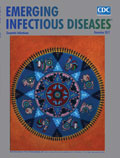
We assessed microbial safety and quality of raw fish sold in Singapore during 2015–2016 to complement epidemiologic findings for an outbreak of infection with group B Streptococcus serotype III sequence type (ST) 283 associated with raw fish consumption. Fish-associated group B Streptococcus ST283 strains included strains nearly identical (0–2 single-nucleotide polymorphisms) with the human outbreak strain, as well as strains in another distinct ST283 clade (57–71 single-nucleotide polymorphisms). Our investigations highlight the risk for contamination of freshwater fish (which are handled and distributed separately from saltwater fish sold as sashimi) and the need for improved hygienic handling of all fish for raw consumption. These results have led to updated policy and guidelines regarding the sale of ready-to-eat raw fish dishes in Singapore.
| EID | Chau ML, Chen SL, Yap M, Hartantyo S, Chiew P, Fernandez CJ, et al. Group B Streptococcus Infections Caused by Improper Sourcing and Handling of Fish for Raw Consumption, Singapore, 2015–2016. Emerg Infect Dis. 2017;23(12):2002-2010. https://doi.org/10.3201/eid2312.170596 |
|---|---|
| AMA | Chau ML, Chen SL, Yap M, et al. Group B Streptococcus Infections Caused by Improper Sourcing and Handling of Fish for Raw Consumption, Singapore, 2015–2016. Emerging Infectious Diseases. 2017;23(12):2002-2010. doi:10.3201/eid2312.170596. |
| APA | Chau, M. L., Chen, S. L., Yap, M., Hartantyo, S., Chiew, P., Fernandez, C. J....Ng, L. C. (2017). Group B Streptococcus Infections Caused by Improper Sourcing and Handling of Fish for Raw Consumption, Singapore, 2015–2016. Emerging Infectious Diseases, 23(12), 2002-2010. https://doi.org/10.3201/eid2312.170596. |
An increase in typhus group rickettsiosis and an expanding geographic range occurred in Texas, USA, over a decade. Because this illness commonly affects children, we retrospectively examined medical records from 2008–2016 at a large Houston-area pediatric hospital and identified 36 cases. The earliest known cases were diagnosed in 2011.
| EID | Erickson T, da Silva J, Nolan MS, Marquez L, Munoz FM, Murray KO. Newly Recognized Pediatric Cases of Typhus Group Rickettsiosis, Houston, Texas, USA. Emerg Infect Dis. 2017;23(12):2068-2071. https://doi.org/10.3201/eid2312.170631 |
|---|---|
| AMA | Erickson T, da Silva J, Nolan MS, et al. Newly Recognized Pediatric Cases of Typhus Group Rickettsiosis, Houston, Texas, USA. Emerging Infectious Diseases. 2017;23(12):2068-2071. doi:10.3201/eid2312.170631. |
| APA | Erickson, T., da Silva, J., Nolan, M. S., Marquez, L., Munoz, F. M., & Murray, K. O. (2017). Newly Recognized Pediatric Cases of Typhus Group Rickettsiosis, Houston, Texas, USA. Emerging Infectious Diseases, 23(12), 2068-2071. https://doi.org/10.3201/eid2312.170631. |
Volume 23, Number 11—November 2017
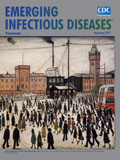
The incidence of Legionnaires’ disease in the United States has been increasing since 2000. Outbreaks and clusters are associated with decorative, recreational, domestic, and industrial water systems, with the largest outbreaks being caused by cooling towers. Since 2006, 6 community-associated Legionnaires’ disease outbreaks have occurred in New York City, resulting in 213 cases and 18 deaths. Three outbreaks occurred in 2015, including the largest on record (138 cases). Three outbreaks were linked to cooling towers by molecular comparison of human and environmental Legionella isolates, and the sources for the other 3 outbreaks were undetermined. The evolution of investigation methods and lessons learned from these outbreaks prompted enactment of a new comprehensive law governing the operation and maintenance of New York City cooling towers. Ongoing surveillance and program evaluation will determine if enforcement of the new cooling tower law reduces Legionnaires’ disease incidence in New York City.
| EID | Fitzhenry R, Weiss D, Cimini D, Balter S, Boyd C, Alleyne L, et al. Legionnaires’ Disease Outbreaks and Cooling Towers, New York City, New York, USA. Emerg Infect Dis. 2017;23(11):1776. https://doi.org/10.3201/eid2311.161584 |
|---|---|
| AMA | Fitzhenry R, Weiss D, Cimini D, et al. Legionnaires’ Disease Outbreaks and Cooling Towers, New York City, New York, USA. Emerging Infectious Diseases. 2017;23(11):1776. doi:10.3201/eid2311.161584. |
| APA | Fitzhenry, R., Weiss, D., Cimini, D., Balter, S., Boyd, C., Alleyne, L....Varma, J. K. (2017). Legionnaires’ Disease Outbreaks and Cooling Towers, New York City, New York, USA. Emerging Infectious Diseases, 23(11), 1776. https://doi.org/10.3201/eid2311.161584. |
In 2015 in Colombia, 60 pregnant women were hospitalized with chikungunya virus infections confirmed by reverse transcription PCR. Nine of these women required admission to the intensive care unit because of sepsis with hypoperfusion and organ dysfunction; these women met the criteria for severe acute maternal morbidity. No deaths occurred. Fifteen women delivered during acute infection; some received tocolytics to delay delivery until after the febrile episode and prevent possible vertical transmission. As recommended by a pediatric neonatologist, 12 neonates were hospitalized to rule out vertical transmission; no clinical findings suggestive of neonatal chikungunya virus infection were observed. With 36 women (60%), follow-up was performed 1 year after acute viremia; 13 patients had arthralgia in >2 joints (a relapse of infection). Despite disease severity, pregnant women with chikungunya should be treated in high-complexity obstetric units to rule out adverse outcomes. These women should also be followed up to treat potential relapses.
| EID | Escobar M, Nieto AJ, Loaiza-Osorio S, Barona JS, Rosso F. Pregnant Women Hospitalized with Chikungunya Virus Infection, Colombia, 2015. Emerg Infect Dis. 2017;23(11):1777-1783. https://doi.org/10.3201/eid2311.170480 |
|---|---|
| AMA | Escobar M, Nieto AJ, Loaiza-Osorio S, et al. Pregnant Women Hospitalized with Chikungunya Virus Infection, Colombia, 2015. Emerging Infectious Diseases. 2017;23(11):1777-1783. doi:10.3201/eid2311.170480. |
| APA | Escobar, M., Nieto, A. J., Loaiza-Osorio, S., Barona, J. S., & Rosso, F. (2017). Pregnant Women Hospitalized with Chikungunya Virus Infection, Colombia, 2015. Emerging Infectious Diseases, 23(11), 1777-1783. https://doi.org/10.3201/eid2311.170480. |
Volume 23, Number 10—October 2017
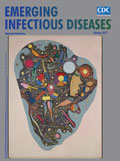
Rocky Mountain spotted fever (RMSF) is an emerging public health concern near the US–Mexico border, where it has resulted in thousands of cases and hundreds of deaths in the past decade. We identified 4 patients who had acquired RMSF in northern Mexico and subsequently died at US healthcare facilities. Two patients sought care in Mexico before being admitted to US-based hospitals. All patients initially had several nonspecific signs and symptoms, including fever, headache, nausea, vomiting, or myalgia, but deteriorated rapidly without receipt of a tetracycline-class antimicrobial drug. Each patient experienced respiratory failure late in illness. Although transborder cases are not common, early recognition and prompt initiation of appropriate treatment are vital for averting severe illness and death. Clinicians on both sides of the US–Mexico border should consider a diagnosis of RMSF for patients with rapidly progressing febrile illness and recent exposure in northern Mexico.
| EID | Drexler NA, Yaglom H, Casal M, Fierro M, Kriner P, Murphy B, et al. Fatal Rocky Mountain Spotted Fever along the United States–Mexico Border, 2013–2016. Emerg Infect Dis. 2017;23(10):1621-1626. https://doi.org/10.3201/eid2310.170309 |
|---|---|
| AMA | Drexler NA, Yaglom H, Casal M, et al. Fatal Rocky Mountain Spotted Fever along the United States–Mexico Border, 2013–2016. Emerging Infectious Diseases. 2017;23(10):1621-1626. doi:10.3201/eid2310.170309. |
| APA | Drexler, N. A., Yaglom, H., Casal, M., Fierro, M., Kriner, P., Murphy, B....Paddock, C. D. (2017). Fatal Rocky Mountain Spotted Fever along the United States–Mexico Border, 2013–2016. Emerging Infectious Diseases, 23(10), 1621-1626. https://doi.org/10.3201/eid2310.170309. |
Hajj, the annual Muslim pilgrimage to Mecca, Saudi Arabia, is a unique mass gathering event that raises public health concerns in the host country and globally. Although gastroenteritis and diarrhea are common among Hajj pilgrims, the microbial etiologies of these infections are unknown. We collected 544 fecal samples from pilgrims with medically attended diarrheal illness from 40 countries during the 2011–2013 Hajj seasons and screened the samples for 16 pathogens commonly associated with diarrheal infections. Bacteria were the main agents detected, in 82.9% of the 228 positive samples, followed by viral (6.1%) and parasitic (5.3%) agents. Salmonella spp., Shigella/enteroinvasive Escherichia coli, and enterotoxigenic E. coli were the main pathogens associated with severe symptoms. We identified genes associated with resistance to third-generation cephalosporins ≈40% of Salmonella- and E. coli–positive samples. Hajj-associated foodborne infections pose a major public health risk through the emergence and transmission of antimicrobial drug–resistant bacteria.
| EID | Abd El Ghany M, Alsomali M, Almasri M, Padron Regalado E, Naeem R, Tukestani A, et al. Enteric Infections Circulating during Hajj Seasons, 2011–2013. Emerg Infect Dis. 2017;23(10):1640-1649. https://doi.org/10.3201/eid2310.161642 |
|---|---|
| AMA | Abd El Ghany M, Alsomali M, Almasri M, et al. Enteric Infections Circulating during Hajj Seasons, 2011–2013. Emerging Infectious Diseases. 2017;23(10):1640-1649. doi:10.3201/eid2310.161642. |
| APA | Abd El Ghany, M., Alsomali, M., Almasri, M., Padron Regalado, E., Naeem, R., Tukestani, A....Memish, Z. A. (2017). Enteric Infections Circulating during Hajj Seasons, 2011–2013. Emerging Infectious Diseases, 23(10), 1640-1649. https://doi.org/10.3201/eid2310.161642. |
Volume 23, Number 9—September 2017
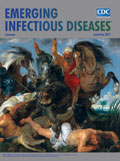
| EID | Gobbi F, Beltrame A, Buonfrate D, Staffolani S, Degani M, Gobbo M, et al. Imported Infections with Mansonella perstans Nematodes, Italy. Emerg Infect Dis. 2017;23(9):1539-1542. https://doi.org/10.3201/eid2309.170263 |
|---|---|
| AMA | Gobbi F, Beltrame A, Buonfrate D, et al. Imported Infections with Mansonella perstans Nematodes, Italy. Emerging Infectious Diseases. 2017;23(9):1539-1542. doi:10.3201/eid2309.170263. |
| APA | Gobbi, F., Beltrame, A., Buonfrate, D., Staffolani, S., Degani, M., Gobbo, M....Bisoffi, Z. (2017). Imported Infections with Mansonella perstans Nematodes, Italy. Emerging Infectious Diseases, 23(9), 1539-1542. https://doi.org/10.3201/eid2309.170263. |
Salmonella enterica serotype Dublin is a cattle-adapted bacterium that typically causes bloodstream infections in humans. To summarize demographic, clinical, and antimicrobial drug resistance characteristics of human infections with this organism in the United States, we analyzed data for 1968–2013 from 5 US surveillance systems. During this period, the incidence rate for infection with Salmonella Dublin increased more than that for infection with other Salmonella. Data from 1 system (FoodNet) showed that a higher percentage of persons with Salmonella Dublin infection were hospitalized and died during 2005−2013 (78% hospitalized, 4.2% died) than during 1996–2004 (68% hospitalized, 2.7% died). Susceptibility data showed that a higher percentage of isolates were resistant to >7 classes of antimicrobial drugs during 2005–2013 (50.8%) than during 1996–2004 (2.4%).
| EID | Harvey R, Friedman CR, Crim SM, Judd M, Barrett KA, Tolar B, et al. Epidemiology of Salmonella enterica Serotype Dublin Infections among Humans, United States, 1968–2013. Emerg Infect Dis. 2017;23(9):1493-1501. https://doi.org/10.3201/eid2309.170136 |
|---|---|
| AMA | Harvey R, Friedman CR, Crim SM, et al. Epidemiology of Salmonella enterica Serotype Dublin Infections among Humans, United States, 1968–2013. Emerging Infectious Diseases. 2017;23(9):1493-1501. doi:10.3201/eid2309.170136. |
| APA | Harvey, R., Friedman, C. R., Crim, S. M., Judd, M., Barrett, K. A., Tolar, B....Brown, A. C. (2017). Epidemiology of Salmonella enterica Serotype Dublin Infections among Humans, United States, 1968–2013. Emerging Infectious Diseases, 23(9), 1493-1501. https://doi.org/10.3201/eid2309.170136. |
Volume 23, Number 8—August 2017
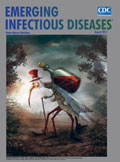
Bartonella quintana endocarditis, a common cause of culture-negative endocarditis in adults, has rarely been reported in children. We describe 5 patients 7–16 years of age from Ethiopia with heart defects and endocarditis; 4 cases were caused by infection with B. quintana and 1 by Bartonella of undetermined species. All 5 patients were afebrile and oligosymptomatic, although 3 had heart failure. C-reactive protein was normal or slightly elevated, and erythrocyte sedimentation rate was high. The diagnosis was confirmed by echocardiographic demonstration of vegetations, the presence of high Bartonella IgG titers, and identification of B. quintana DNA in excised vegetations. Embolic events were diagnosed in 2 patients. Our data suggest that B. quintana is not an uncommon cause of native valve endocarditis in children in Ethiopia with heart defects and that possible B. quintana infection should be suspected and pursued among residents of and immigrants from East Africa, including Ethiopia, with culture-negative endocarditis.
| EID | Tasher D, Raucher-Sternfeld A, Tamir A, Giladi M, Somekh E. Bartonella quintana, an Unrecognized Cause of Infective Endocarditis in Children in Ethiopia. Emerg Infect Dis. 2017;23(8):1246-1252. https://doi.org/10.3201/eid2308.161037 |
|---|---|
| AMA | Tasher D, Raucher-Sternfeld A, Tamir A, et al. Bartonella quintana, an Unrecognized Cause of Infective Endocarditis in Children in Ethiopia. Emerging Infectious Diseases. 2017;23(8):1246-1252. doi:10.3201/eid2308.161037. |
| APA | Tasher, D., Raucher-Sternfeld, A., Tamir, A., Giladi, M., & Somekh, E. (2017). Bartonella quintana, an Unrecognized Cause of Infective Endocarditis in Children in Ethiopia. Emerging Infectious Diseases, 23(8), 1246-1252. https://doi.org/10.3201/eid2308.161037. |
Human metapneumovirus (HMPV) is a respiratory virus that can cause severe lower respiratory tract disease and even death, primarily in young children. The incidence and characteristics of HMPV have not been well described in pregnant women. As part of a trial of maternal influenza immunization in rural southern Nepal, we conducted prospective, longitudinal, home-based active surveillance for febrile respiratory illness during pregnancy through 6 months postpartum. During 2011–2014, HMPV was detected in 55 of 3,693 women (16.4 cases/1,000 person-years). Twenty-five women were infected with HMPV during pregnancy, compared with 98 pregnant women who contracted rhinovirus and 7 who contracted respiratory syncytial virus. Women with HMPV during pregnancy had an increased risk of giving birth to infants who were small for gestational age. An intervention to reduce HMPV febrile respiratory illness in pregnant women may have the potential to decrease risk of adverse birth outcomes in developing countries.
| EID | Lenahan JL, Englund JA, Katz J, Kuypers J, Wald A, Magaret A, et al. Human Metapneumovirus and Other Respiratory Viral Infections during Pregnancy and Birth, Nepal. Emerg Infect Dis. 2017;23(8):1341-1349. https://doi.org/10.3201/eid2308.161358 |
|---|---|
| AMA | Lenahan JL, Englund JA, Katz J, et al. Human Metapneumovirus and Other Respiratory Viral Infections during Pregnancy and Birth, Nepal. Emerging Infectious Diseases. 2017;23(8):1341-1349. doi:10.3201/eid2308.161358. |
| APA | Lenahan, J. L., Englund, J. A., Katz, J., Kuypers, J., Wald, A., Magaret, A....Chu, H. Y. (2017). Human Metapneumovirus and Other Respiratory Viral Infections during Pregnancy and Birth, Nepal. Emerging Infectious Diseases, 23(8), 1341-1349. https://doi.org/10.3201/eid2308.161358. |
Volume 23, Number 7—July 2017
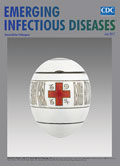
The incidence of group C and G Streptococcus (GCGS) bacteremia, which is associated with severe disease and death, is increasing. We characterized clinical features, outcomes, and genetic determinants of GCGS bacteremia for 89 patients in Winnipeg, Manitoba, Canada, who had GCGS bacteremia during 2012–2014. Of the 89 patients, 51% had bacteremia from skin and soft tissue, 70% had severe disease features, and 20% died. Whole-genome sequencing analysis was performed on isolates derived from 89 blood samples and 33 respiratory sample controls: 5 closely related genetic lineages were identified as being more likely to cause invasive disease than non-clade isolates (83% vs. 57%, p = 0.002). Virulence factors cbp, fbp, speG, sicG, gfbA, and bca clustered clonally into these clades. A clonal distribution of virulence factors may account for severe and fatal cases of bacteremia caused by invasive GCGS.
| EID | Lother SA, Demczuk W, Martin I, Mulvey MR, Dufault B, Lagacé-Wiens P, et al. Clonal Clusters and Virulence Factors of Group C and G Streptococcus Causing Severe Infections, Manitoba, Canada, 2012–2014. Emerg Infect Dis. 2017;23(7):1092-1101. https://doi.org/10.3201/eid2307.161259 |
|---|---|
| AMA | Lother SA, Demczuk W, Martin I, et al. Clonal Clusters and Virulence Factors of Group C and G Streptococcus Causing Severe Infections, Manitoba, Canada, 2012–2014. Emerging Infectious Diseases. 2017;23(7):1092-1101. doi:10.3201/eid2307.161259. |
| APA | Lother, S. A., Demczuk, W., Martin, I., Mulvey, M. R., Dufault, B., Lagacé-Wiens, P....Keynan, Y. (2017). Clonal Clusters and Virulence Factors of Group C and G Streptococcus Causing Severe Infections, Manitoba, Canada, 2012–2014. Emerging Infectious Diseases, 23(7), 1092-1101. https://doi.org/10.3201/eid2307.161259. |
Legionella longbeachae, found in soil and compost-derived products, is a globally underdiagnosed cause of Legionnaires’ disease. We conducted a case–control study of L. longbeachae Legionnaires’ disease in Canterbury, New Zealand. Case-patients were persons hospitalized with L. longbeachae pneumonia, and controls were persons randomly sampled from the electoral roll for the area served by the participating hospital. Among 31 cases and 172 controls, risk factors for Legionnaires’ disease were chronic obstructive pulmonary disease, history of smoking >10 years, and exposure to compost or potting mix. Gardening behaviors associated with L. longbeachae disease included having unwashed hands near the face after exposure to or tipping and troweling compost or potting mix. Mask or glove use was not protective among persons exposed to compost-derived products. Precautions against inhaling compost and attention to hand hygiene might effectively prevent L. longbeachae disease. Long-term smokers and those with chronic obstructive pulmonary disease should be particularly careful.
| EID | Kenagy E, Priest PC, Cameron CM, Smith D, Scott P, Cho V, et al. Risk Factors for Legionella longbeachae Legionnaires’ Disease, New Zealand. Emerg Infect Dis. 2017;23(7):1148-1154. https://doi.org/10.3201/eid2307.161429 |
|---|---|
| AMA | Kenagy E, Priest PC, Cameron CM, et al. Risk Factors for Legionella longbeachae Legionnaires’ Disease, New Zealand. Emerging Infectious Diseases. 2017;23(7):1148-1154. doi:10.3201/eid2307.161429. |
| APA | Kenagy, E., Priest, P. C., Cameron, C. M., Smith, D., Scott, P., Cho, V....Murdoch, D. R. (2017). Risk Factors for Legionella longbeachae Legionnaires’ Disease, New Zealand. Emerging Infectious Diseases, 23(7), 1148-1154. https://doi.org/10.3201/eid2307.161429. |
Volume 23, Number 6—June 2017
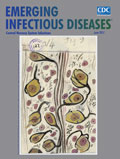
Sporadic Creutzfeldt-Jakob disease (sCJD) has not been previously reported in patients with clotting disorders treated with fractionated plasma products. We report 2 cases of sCJD identified in the United Kingdom in patients with a history of extended treatment for clotting disorders; 1 patient had hemophilia B and the other von Willebrand disease. Both patients had been informed previously that they were at increased risk for variant CJD because of past treatment with fractionated plasma products sourced in the United Kingdom. However, both cases had clinical and investigative features suggestive of sCJD. This diagnosis was confirmed in both cases on neuropathologic and biochemical analysis of the brain. A causal link between the treatment with plasma products and the development of sCJD has not been established, and the occurrence of these cases may simply reflect a chance event in the context of systematic surveillance for CJD in large populations.
| EID | Urwin P, Thanigaikumar K, Ironside JW, Molesworth A, Knight RS, Hewitt PE, et al. Sporadic Creutzfeldt-Jakob Disease in 2 Plasma Product Recipients, United Kingdom. Emerg Infect Dis. 2017;23(6):893-897. https://doi.org/10.3201/eid2306.161884 |
|---|---|
| AMA | Urwin P, Thanigaikumar K, Ironside JW, et al. Sporadic Creutzfeldt-Jakob Disease in 2 Plasma Product Recipients, United Kingdom. Emerging Infectious Diseases. 2017;23(6):893-897. doi:10.3201/eid2306.161884. |
| APA | Urwin, P., Thanigaikumar, K., Ironside, J. W., Molesworth, A., Knight, R. S., Hewitt, P. E....Will, R. G. (2017). Sporadic Creutzfeldt-Jakob Disease in 2 Plasma Product Recipients, United Kingdom. Emerging Infectious Diseases, 23(6), 893-897. https://doi.org/10.3201/eid2306.161884. |
The lone star tick, Amblyomma americanum, is a vector of Ehrlichia chaffeensis and E. ewingii, causal agents of human ehrlichiosis, and has demonstrated marked geographic expansion in recent years. A. americanum ticks often outnumber the vector of Lyme disease, Ixodes scapularis, where both ticks are sympatric, yet cases of Lyme disease far exceed ehrlichiosis cases. We quantified the risk for ehrlichiosis relative to Lyme disease by using relative tick encounter frequencies and infection rates for these 2 species in Monmouth County, New Jersey, USA. Our calculations predict >1 ehrlichiosis case for every 2 Lyme disease cases, >2 orders of magnitude higher than current case rates (e.g., 2 ehrlichiosis versus 439 Lyme disease cases in 2014). This result implies ehrlichiosis is grossly underreported (or misreported) or that many infections are asymptomatic. We recommend expansion of tickborne disease education in the Northeast United States to include human health risks posed by A. americanum ticks.
| EID | Egizi A, Fefferman NH, Jordan RA. Relative Risk for Ehrlichiosis and Lyme Disease in an Area Where Vectors for Both Are Sympatric, New Jersey, USA. Emerg Infect Dis. 2017;23(6):939-945. https://doi.org/10.3201/eid2306.160528 |
|---|---|
| AMA | Egizi A, Fefferman NH, Jordan RA. Relative Risk for Ehrlichiosis and Lyme Disease in an Area Where Vectors for Both Are Sympatric, New Jersey, USA. Emerging Infectious Diseases. 2017;23(6):939-945. doi:10.3201/eid2306.160528. |
| APA | Egizi, A., Fefferman, N. H., & Jordan, R. A. (2017). Relative Risk for Ehrlichiosis and Lyme Disease in an Area Where Vectors for Both Are Sympatric, New Jersey, USA. Emerging Infectious Diseases, 23(6), 939-945. https://doi.org/10.3201/eid2306.160528. |
Volume 23, Number 5—May 2017
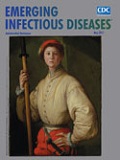
| EID | de St. Maurice A, Ervin E, Schumacher M, Yaglom H, VinHatton E, Melman S, et al. Exposure Characteristics of Hantavirus Pulmonary Syndrome Patients, United States, 1993–2015. Emerg Infect Dis. 2017;23(5):733-739. https://doi.org/10.3201/eid2305.161770 |
|---|---|
| AMA | de St. Maurice A, Ervin E, Schumacher M, et al. Exposure Characteristics of Hantavirus Pulmonary Syndrome Patients, United States, 1993–2015. Emerging Infectious Diseases. 2017;23(5):733-739. doi:10.3201/eid2305.161770. |
| APA | de St. Maurice, A., Ervin, E., Schumacher, M., Yaglom, H., VinHatton, E., Melman, S....Knust, B. (2017). Exposure Characteristics of Hantavirus Pulmonary Syndrome Patients, United States, 1993–2015. Emerging Infectious Diseases, 23(5), 733-739. https://doi.org/10.3201/eid2305.161770. |
Neurologic melioidosis is a serious, potentially fatal form of Burkholderia pseudomallei infection. Recently, we reported that a subset of clinical isolates of B. pseudomallei from Australia have heightened virulence and potential for dissemination to the central nervous system. In this study, we demonstrate that this subset has a B. mallei–like sequence variation of the actin-based motility gene, bimA. Compared with B. pseudomallei isolates having typical bimA alleles, isolates that contain the B. mallei–like variation demonstrate increased persistence in phagocytic cells and increased virulence with rapid systemic dissemination and replication within multiple tissues, including the brain and spinal cord, in an experimental model. These findings highlight the implications of bimA variation on disease progression of B. pseudomallei infection and have considerable clinical and public health implications with respect to the degree of neurotropic threat posed to human health.
| EID | Morris JL, Fane A, Sarovich D, Price EP, Rush CM, Govan BL, et al. Increased Neurotropic Threat from Burkholderia pseudomallei Strains with a B. mallei–like Variation in the bimA Motility Gene, Australia. Emerg Infect Dis. 2017;23(5):740-749. https://doi.org/10.3201/eid2305.151417 |
|---|---|
| AMA | Morris JL, Fane A, Sarovich D, et al. Increased Neurotropic Threat from Burkholderia pseudomallei Strains with a B. mallei–like Variation in the bimA Motility Gene, Australia. Emerging Infectious Diseases. 2017;23(5):740-749. doi:10.3201/eid2305.151417. |
| APA | Morris, J. L., Fane, A., Sarovich, D., Price, E. P., Rush, C. M., Govan, B. L....Ketheesan, N. (2017). Increased Neurotropic Threat from Burkholderia pseudomallei Strains with a B. mallei–like Variation in the bimA Motility Gene, Australia. Emerging Infectious Diseases, 23(5), 740-749. https://doi.org/10.3201/eid2305.151417. |
Volume 23, Number 4—April 2017
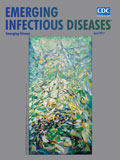
We characterized influenza B virus–related neurologic manifestations in an unusually high number of hospitalized adults at a tertiary care facility in Romania during the 2014–15 influenza epidemic season. Of 32 patients with a confirmed laboratory diagnosis of influenza B virus infection, neurologic complications developed in 7 adults (median age 31 years). These complications were clinically diagnosed as confirmed encephalitis (4 patients), possible encephalitis (2 patients), and cerebellar ataxia (1 patient). Two of the patients died. Virus sequencing identified influenza virus B (Yam)-lineage clade 3, which is representative of the B/Phuket/3073/2013 strain, in 4 patients. None of the patients had been vaccinated against influenza. These results suggest that influenza B virus can cause a severe clinical course and should be considered as an etiologic factor for encephalitis.
| EID | Popescu CP, Florescu SA, Lupulescu E, Zaharia M, Tardei G, Lazar M, et al. Neurologic Complications of Influenza B Virus Infection in Adults, Romania. Emerg Infect Dis. 2017;23(4):574-581. https://doi.org/10.3201/eid2304.161317 |
|---|---|
| AMA | Popescu CP, Florescu SA, Lupulescu E, et al. Neurologic Complications of Influenza B Virus Infection in Adults, Romania. Emerging Infectious Diseases. 2017;23(4):574-581. doi:10.3201/eid2304.161317. |
| APA | Popescu, C. P., Florescu, S. A., Lupulescu, E., Zaharia, M., Tardei, G., Lazar, M....Ruta, S. M. (2017). Neurologic Complications of Influenza B Virus Infection in Adults, Romania. Emerging Infectious Diseases, 23(4), 574-581. https://doi.org/10.3201/eid2304.161317. |
Although transmission of hepatitis A virus (HAV) through blood transfusion has been documented, transmission through organ transplantation has not been reported. In August 2015, state health officials in Texas, USA, were notified of 2 home health nurses with HAV infection whose only common exposure was a child who had undergone multi–visceral organ transplantation 9 months earlier. Specimens from the nurses, organ donor, and all organ recipients were tested and medical records reviewed to determine a possible infection source. Identical HAV RNA sequences were detected from the serum of both nurses and the organ donor, as well as from the multi–visceral organ recipient’s serum and feces; this recipient’s posttransplant liver and intestine biopsy specimens also had detectable virus. The other organ recipients tested negative for HAV RNA. Vaccination of the donor might have prevented infection in the recipient and subsequent transmission to the healthcare workers.
| EID | Foster MA, Weil LM, Jin S, Johnson T, Hayden-Mixson TR, Khudyakov Y, et al. Transmission of Hepatitis A Virus through Combined Liver–Small Intestine–Pancreas Transplantation. Emerg Infect Dis. 2017;23(4):590-596. https://doi.org/10.3201/eid2304.161532 |
|---|---|
| AMA | Foster MA, Weil LM, Jin S, et al. Transmission of Hepatitis A Virus through Combined Liver–Small Intestine–Pancreas Transplantation. Emerging Infectious Diseases. 2017;23(4):590-596. doi:10.3201/eid2304.161532. |
| APA | Foster, M. A., Weil, L. M., Jin, S., Johnson, T., Hayden-Mixson, T. R., Khudyakov, Y....Moorman, A. C. (2017). Transmission of Hepatitis A Virus through Combined Liver–Small Intestine–Pancreas Transplantation. Emerging Infectious Diseases, 23(4), 590-596. https://doi.org/10.3201/eid2304.161532. |
Volume 23, Number 3—March 2017
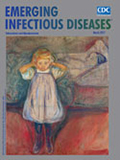
Despite control efforts, Mycobacterium bovis incidence among cattle remains high in parts of England, Wales, and Northern Ireland, attracting political and public health interest in potential spread from animals to humans. To determine incidence among humans and to identify associated factors, we conducted a retrospective cohort analysis of human M. bovis cases in England, Wales, and Northern Ireland during 2002–2014. We identified 357 cases and observed increased annual case numbers (from 17 to 35) and rates. Most patients were >65 years of age and born in the United Kingdom. The median age of UK-born patients decreased over time. For 74% of patients, exposure to risk factors accounting for M. bovis acquisition, most frequently consumption of unpasteurized milk, was known. Despite the small increase in case numbers and reduction in patient age, M. bovis infection of humans in England, Wales, and Northern Ireland remains rare.
| EID | Davidson JA, Loutet MG, O’Connor C, Kearns C, Smith R, Lalor MK, et al. Epidemiology of Mycobacterium bovis Disease in Humans in England, Wales, and Northern Ireland, 2002–2014. Emerg Infect Dis. 2017;23(3):377-386. https://doi.org/10.3201/eid2303.161408 |
|---|---|
| AMA | Davidson JA, Loutet MG, O’Connor C, et al. Epidemiology of Mycobacterium bovis Disease in Humans in England, Wales, and Northern Ireland, 2002–2014. Emerging Infectious Diseases. 2017;23(3):377-386. doi:10.3201/eid2303.161408. |
| APA | Davidson, J. A., Loutet, M. G., O’Connor, C., Kearns, C., Smith, R., Lalor, M. K....Zenner, D. (2017). Epidemiology of Mycobacterium bovis Disease in Humans in England, Wales, and Northern Ireland, 2002–2014. Emerging Infectious Diseases, 23(3), 377-386. https://doi.org/10.3201/eid2303.161408. |
In April 2014, a kidney transplant recipient in the United States experienced headache, diplopia, and confusion, followed by neurologic decline and death. An investigation to evaluate the possibility of donor-derived infection determined that 3 patients had received 4 organs (kidney, liver, heart/kidney) from the same donor. The liver recipient experienced tremor and gait instability; the heart/kidney and contralateral kidney recipients were hospitalized with encephalitis. None experienced gastrointestinal symptoms. Encephalitozoon cuniculi was detected by tissue PCR in the central nervous system of the deceased kidney recipient and in renal allograft tissue from both kidney recipients. Urine PCR was positive for E. cuniculi in the 2 surviving recipients. Donor serum was positive for E. cuniculi antibodies. E. cuniculi was transmitted to 3 recipients from 1 donor. This rare presentation of disseminated disease resulted in diagnostic delays. Clinicians should consider donor-derived microsporidial infection in organ recipients with unexplained encephalitis, even when gastrointestinal manifestations are absent.
| EID | Smith R, Muehlenbachs A, Schaenmann J, Baxi S, Koo S, Blau D, et al. Three Cases of Neurologic Syndrome Caused by Donor-Derived Microsporidiosis. Emerg Infect Dis. 2017;23(3):387-395. https://doi.org/10.3201/eid2303.161580 |
|---|---|
| AMA | Smith R, Muehlenbachs A, Schaenmann J, et al. Three Cases of Neurologic Syndrome Caused by Donor-Derived Microsporidiosis. Emerging Infectious Diseases. 2017;23(3):387-395. doi:10.3201/eid2303.161580. |
| APA | Smith, R., Muehlenbachs, A., Schaenmann, J., Baxi, S., Koo, S., Blau, D....Zaki, S. (2017). Three Cases of Neurologic Syndrome Caused by Donor-Derived Microsporidiosis. Emerging Infectious Diseases, 23(3), 387-395. https://doi.org/10.3201/eid2303.161580. |
Volume 23, Number 2—February 2017
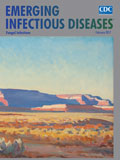
Candida auris and C. haemulonii are closely related, multidrug-resistant emerging fungal pathogens that are not readily distinguishable with phenotypic assays. We studied C. auris and C. haemulonii clinical isolates from 2 hospitals in central Israel. C. auris was isolated in 5 patients with nosocomial bloodstream infection, and C. haemulonii was found as a colonizer of leg wounds at a peripheral vascular disease clinic. Liberal use of topical miconazole and close contact among patients were implicated in C. haemulonii transmission. C. auris exhibited higher thermotolerance, virulence in a mouse infection model, and ATP-dependent drug efflux activity than C. haemulonii. Comparison of ribosomal DNA sequences found that C. auris strains from Israel were phylogenetically distinct from isolates from East Asia, South Africa and Kuwait, whereas C. haemulonii strains from different countries were closely interrelated. Our findings highlight the pathogenicity of C. auris and underscore the need to limit its spread.
| EID | Ben-Ami R, Berman J, Novikov A, Bash E, Shachor-Meyouhas Y, Zakin S, et al. Multidrug-Resistant Candida haemulonii and C. auris, Tel Aviv, Israel. Emerg Infect Dis. 2017;23(2):195-203. https://doi.org/10.3201/eid2302.161486 |
|---|---|
| AMA | Ben-Ami R, Berman J, Novikov A, et al. Multidrug-Resistant Candida haemulonii and C. auris, Tel Aviv, Israel. Emerging Infectious Diseases. 2017;23(2):195-203. doi:10.3201/eid2302.161486. |
| APA | Ben-Ami, R., Berman, J., Novikov, A., Bash, E., Shachor-Meyouhas, Y., Zakin, S....Finn, T. (2017). Multidrug-Resistant Candida haemulonii and C. auris, Tel Aviv, Israel. Emerging Infectious Diseases, 23(2), 195-203. https://doi.org/10.3201/eid2302.161486. |
Of 150,000 new coccidioidomycosis infections that occur annually in the United States, ≈1% disseminate; one third of those cases are fatal. Immunocompromised hosts have higher rates of dissemination. We identified 8 patients with disseminated coccidioidomycosis who had defects in the interleukin-12/interferon-γ and STAT3 axes, indicating that these are critical host defense pathways.
| EID | Odio CD, Marciano BE, Galgiani JN, Holland SM. Risk Factors for Disseminated Coccidioidomycosis, United States. Emerg Infect Dis. 2017;23(2):311. https://doi.org/10.3201/eid2302.160505 |
|---|---|
| AMA | Odio CD, Marciano BE, Galgiani JN, et al. Risk Factors for Disseminated Coccidioidomycosis, United States. Emerging Infectious Diseases. 2017;23(2):311. doi:10.3201/eid2302.160505. |
| APA | Odio, C. D., Marciano, B. E., Galgiani, J. N., & Holland, S. M. (2017). Risk Factors for Disseminated Coccidioidomycosis, United States. Emerging Infectious Diseases, 23(2), 311. https://doi.org/10.3201/eid2302.160505. |
Volume 23, Number 1—January 2017
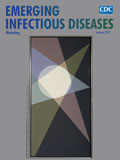
Invasive candidiasis is a major nosocomial fungal disease in the United States associated with high rates of illness and death. We analyzed inpatient hospitalization records from the Healthcare Cost and Utilization Project to estimate incidence of invasive candidiasis–associated hospitalizations in the United States. We extracted data for 33 states for 2002–2012 by using codes from the International Classification of Diseases, 9th Revision, Clinical Modification, for invasive candidiasis; we excluded neonatal cases. The overall age-adjusted average annual rate was 5.3 hospitalizations/100,000 population. Highest risk was for adults >65 years of age, particularly men. Median length of hospitalization was 21 days; 22% of patients died during hospitalization. Median unadjusted associated cost for inpatient care was $46,684. Age-adjusted annual rates decreased during 2005–2012 for men (annual change –3.9%) and women (annual change –4.5%) and across nearly all age groups. We report a high mortality rate and decreasing incidence of hospitalizations for this disease.
| EID | Strollo S, Lionakis MS, Adjemian J, Steiner CA, Prevots D. Epidemiology of Hospitalizations Associated with Invasive Candidiasis, United States, 2002–2012. Emerg Infect Dis. 2017;23(1):7-13. https://doi.org/10.3201/eid2301.161198 |
|---|---|
| AMA | Strollo S, Lionakis MS, Adjemian J, et al. Epidemiology of Hospitalizations Associated with Invasive Candidiasis, United States, 2002–2012. Emerging Infectious Diseases. 2017;23(1):7-13. doi:10.3201/eid2301.161198. |
| APA | Strollo, S., Lionakis, M. S., Adjemian, J., Steiner, C. A., & Prevots, D. (2017). Epidemiology of Hospitalizations Associated with Invasive Candidiasis, United States, 2002–2012. Emerging Infectious Diseases, 23(1), 7-13. https://doi.org/10.3201/eid2301.161198. |
We studied anthrax immune globulin intravenous (AIG-IV) use from a 2009–2010 outbreak of Bacillus anthracis soft tissue infection in injection drug users in Scotland, UK, and we compared findings from 15 AIG-IV recipients with findings from 28 nonrecipients. Death rates did not differ significantly between recipients and nonrecipients (33% vs. 21%). However, whereas only 8 (27%) of 30 patients at low risk for death (admission sequential organ failure assessment score of 0–5) received AIG-IV, 7 (54%) of the 13 patients at high risk for death (sequential organ failure assessment score of 6–11) received treatment. AIG-IV recipients had surgery more often and, among survivors, had longer hospital stays than did nonrecipients. AIG-IV recipients were sicker than nonrecipients. This difference and the small number of higher risk patients confound assessment of AIG-IV effectiveness in this outbreak.
| EID | Cui X, Nolen LD, Sun J, Booth M, Donaldson L, Quinn CP, et al. Analysis of Anthrax Immune Globulin Intravenous with Antimicrobial Treatment in Injection Drug Users, Scotland, 2009–2010. Emerg Infect Dis. 2017;23(1):56-65. https://doi.org/10.3201/eid2301.160608 |
|---|---|
| AMA | Cui X, Nolen LD, Sun J, et al. Analysis of Anthrax Immune Globulin Intravenous with Antimicrobial Treatment in Injection Drug Users, Scotland, 2009–2010. Emerging Infectious Diseases. 2017;23(1):56-65. doi:10.3201/eid2301.160608. |
| APA | Cui, X., Nolen, L. D., Sun, J., Booth, M., Donaldson, L., Quinn, C. P....Eichacker, P. Q. (2017). Analysis of Anthrax Immune Globulin Intravenous with Antimicrobial Treatment in Injection Drug Users, Scotland, 2009–2010. Emerging Infectious Diseases, 23(1), 56-65. https://doi.org/10.3201/eid2301.160608. |
CME Articles by Volume




